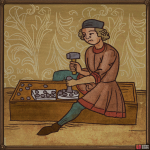Text
Manual coin minting was a complex process in the Middle Ages.
After the raw silver was mined and processed, ingots, known ascans, were made from the precious metal alloy. The ingots were then hammered into thin, narrow strips by the minters, from which squares, so-called farfule, were cut with large shears and then rounded. The slices were then hammered into a circular shape on the anvil and then smoothed by a process known as clipping.
Only then could the coiner, known as a pregéř, step in to insert the coin between two dies at the minting tables and strike it with a hammer. Since great strength was required, the coiner had to be a mountain of a man: one hand was needed to hold the two stamps together, the other to pound them with a heavy hammer. Later on, when thalers replaced Prague groschen, two people were needed for minting.
The activity was very noisy and had to be well-guarded. Most engravers eventually became partially deaf and were not allowed to wear clothing with loose folds or pockets, which could be used to conceal something.
Imperfect coins were collected and subsequently melted down to be reminted.


No Comments